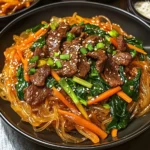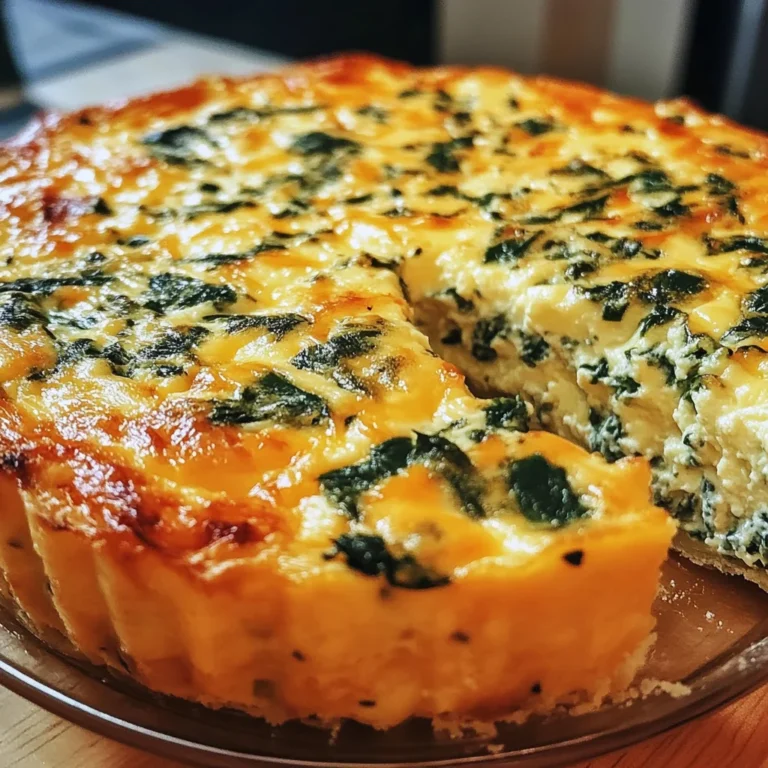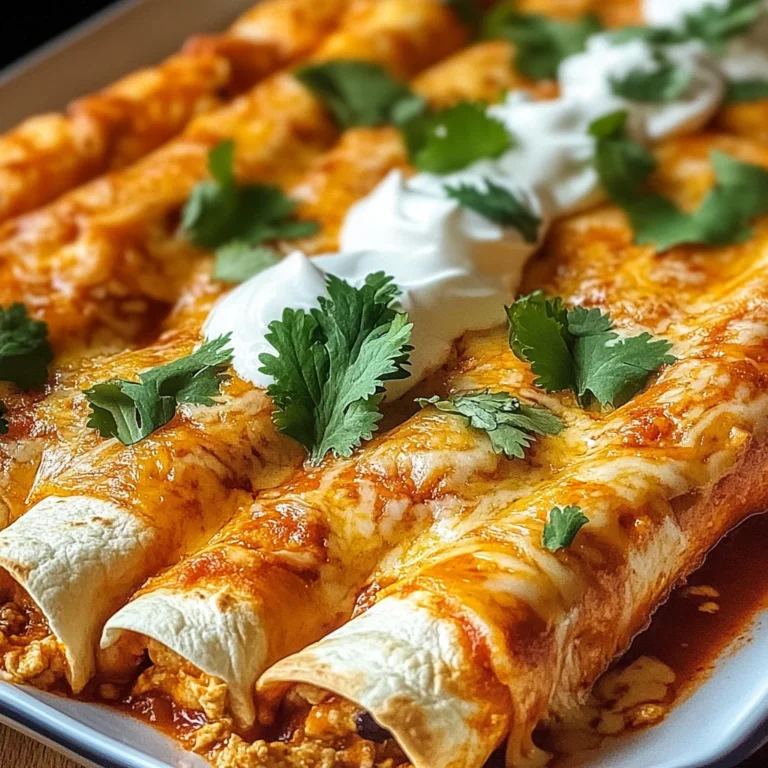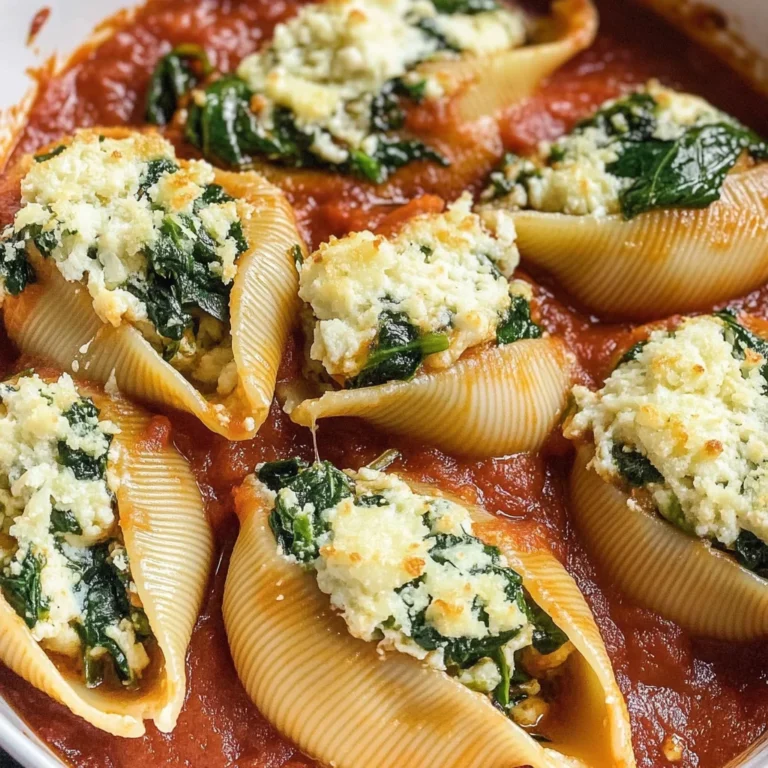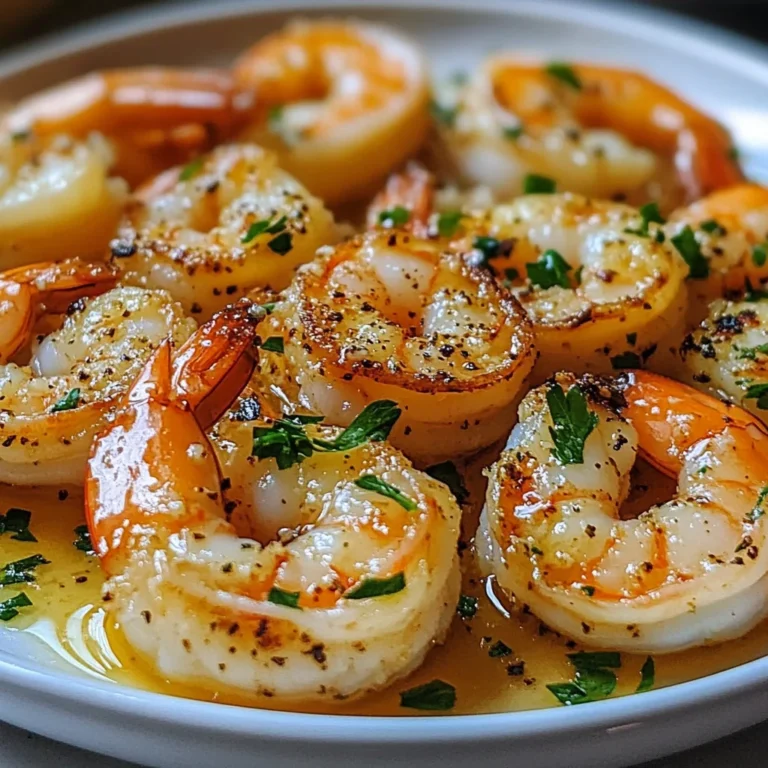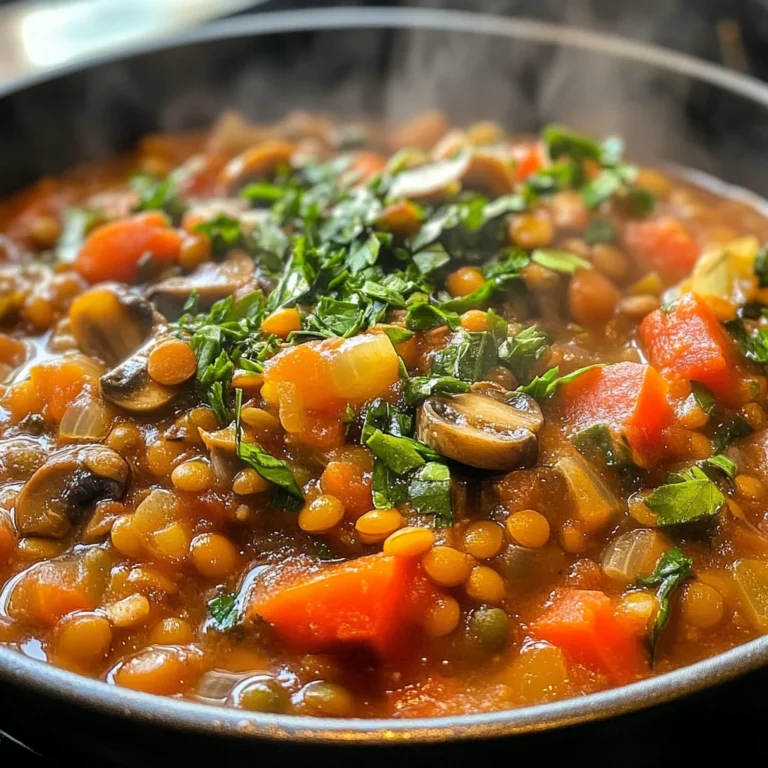Japchae
If you’re looking for a dish that brings comfort and joy to the table, Japchae is it! This traditional Korean recipe showcases sweet potato glass noodles that are not only chewy but also delightfully flavorful. It’s one of those meals that feels special but is surprisingly easy to whip up, making it perfect for busy weeknights or family gatherings. The vibrant mix of vegetables and the savory-sweet sauce come together in a way that feels both homey and exciting.
What I love most about Japchae is how adaptable it is. Whether you’re in the mood for beef, chicken, or tofu (or even a hint of spice with some gochujang), this dish has room for all your cravings. Each bite is a wonderful blend of textures and tastes, reminding us of the warmth of shared meals and good company.
Why You’ll Love This Recipe
- Easy to make: With just a few simple steps, you can have a delicious meal on the table in no time.
- Family-friendly: Kids and adults alike love the fun texture of sweet potato noodles and colorful veggies.
- Customizable: You can easily swap proteins or add your favorite veggies to make it your own.
- Make-ahead friendly: Japchae stores well in the fridge, making it perfect for meal prep or leftovers.
- Delicious flavor: The combination of soy sauce, sesame oil, and fresh ingredients creates a delightful taste experience.

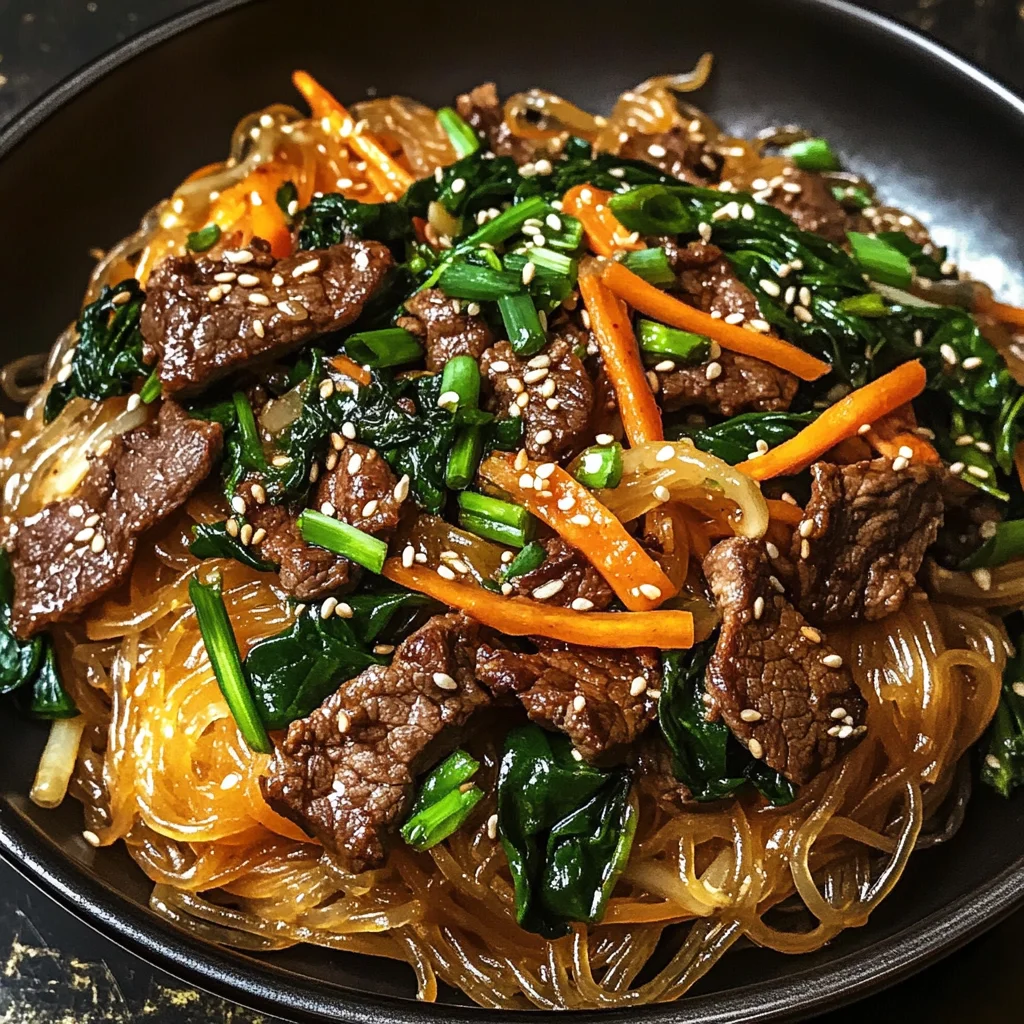
Ingredients You’ll Need
These ingredients are simple and wholesome, making it easy to create a dish that’s full of flavor. Gather these items before diving into your cooking adventure!
- 2 lb thin-sliced beef (or sub with chicken, tofu, or shrimp)
- 1 lb Korean sweet potato noodles (glass noodles)
- 3 medium carrots, julienned
- 1 large white onion, thinly sliced
- 1/2 bunch green onions, chopped
- 6 garlic cloves, minced
- 1/2 lb spinach leaves
- 4 tbsp sesame oil (divided)
- 1 tbsp olive oil
- 6 tbsp soy sauce (or tamari for gluten-free)
- 3 tbsp brown sugar
Variations
One of the best parts about Japchae is its flexibility! You can easily adjust the recipe based on what you have on hand or your personal preferences. Here are some fun ideas:
- Swap the protein: Feel free to use chicken or tofu instead of beef for different flavors and textures.
- Add some heat: If you like spice, try adding a spoonful of gochujang while cooking for a kick!
- Mix in more veggies: Broccoli, bell peppers, or snap peas would be great additions for extra crunch.
- Go gluten-free: Use tamari instead of soy sauce to make this dish suitable for gluten-free diets.
How to Make Japchae
Step 1: Cook the Noodles
Start by bringing water to a boil in a large pot with a drizzle of olive oil. Add the sweet potato noodles and cook them for about 5-6 minutes until they are tender yet chewy. This step is crucial as it preps the noodles to soak up all those delicious flavors later on. Once cooked, drain them and set aside.
Step 2: Sauté the Beef
In a skillet over high heat, cook your sliced beef until it’s beautifully browned. As it cooks, season with half of your soy sauce, sesame oil, and brown sugar. This not only adds flavor but also helps tenderize the meat. Once done, set it aside while you prepare the veggies.
Step 3: Cook the Vegetables
In another skillet, heat some olive oil over medium heat. Add your julienned carrots and sliced onion first; cook until they’re softened. Then stir in the remaining soy sauce, sesame oil, and brown sugar along with minced garlic and chopped green onions. This will create an aromatic base that enhances all your ingredients.
Step 4: Add Spinach
Next up is adding your spinach leaves to the skillet! Stir them in until they wilt down beautifully—this adds color and nutrition to your dish. Once wilted, combine all your cooked veggies with the sautéed beef.
Step 5: Toss Everything Together
Now it’s time to bring everything together! In a large bowl, toss your cooked noodles with all those vibrant vegetables and beef until everything is well mixed. Serve warm right away! For an extra touch of freshness, garnish with additional green onions if desired.
Enjoy every bite of this comforting Japchae recipe—it’s sure to become a favorite at your table too!
Pro Tips for Making Japchae
Making the perfect Japchae is all about balancing flavors and textures, and I’m here to help you nail it! Here are some handy tips to bring your dish to the next level:
-
Prep Ingredients Ahead: Having all your ingredients chopped and ready to go will streamline your cooking process, allowing you to focus on achieving the right stir-fry technique without feeling rushed.
-
Don’t Overcook the Noodles: Sweet potato noodles need just 5-6 minutes in boiling water. Overcooking them can lead to a mushy texture, which isn’t what we want. A little chewiness is key!
-
Use High Heat for Stir-Frying: Cooking over high heat helps to sear the ingredients quickly, enhancing their flavors while maintaining their vibrant colors and crunchiness.
-
Customize Your Protein: Feel free to experiment with different proteins like chicken, tofu, or shrimp. Each option brings its own unique flavor and can cater to various dietary preferences.
-
Taste and Adjust Seasoning: Everyone’s taste buds are different! After mixing everything together, give it a taste and adjust the soy sauce or sesame oil as needed for that perfect balance of savory sweetness.
How to Serve Japchae
Once you’ve perfected your Japchae, it’s time to think about how best to present this gorgeous dish! Japchae can be served as a main course or as part of a larger spread. Here are some ideas:
Garnishes
- Sesame Seeds: A sprinkle of toasted sesame seeds adds a lovely nutty flavor and a bit of crunch.
- Fresh Cilantro: Chopped cilantro provides a refreshing herbal note that complements the dish beautifully.
- Red Pepper Flakes: For those who enjoy a kick of heat, a dash of red pepper flakes will elevate the flavor profile nicely.
Side Dishes
- Kimchi: This classic Korean side dish made from fermented vegetables adds a spicy tang that contrasts well with the sweet flavors of Japchae.
- Korean Spinach Salad (Sigeumchi Namul): Lightly seasoned with sesame oil and garlic, this salad offers a fresh and nutritious complement.
- Pickled Radish: The crispness and acidity of pickled radish provide a delightful crunch alongside the soft noodles.
- Rice: A simple bowl of steamed white rice is always a great accompaniment, helping to soak up any extra sauce from your Japchae.
Now you’re ready to impress your family or guests with this vibrant and delicious Japchae! Enjoy every bite!

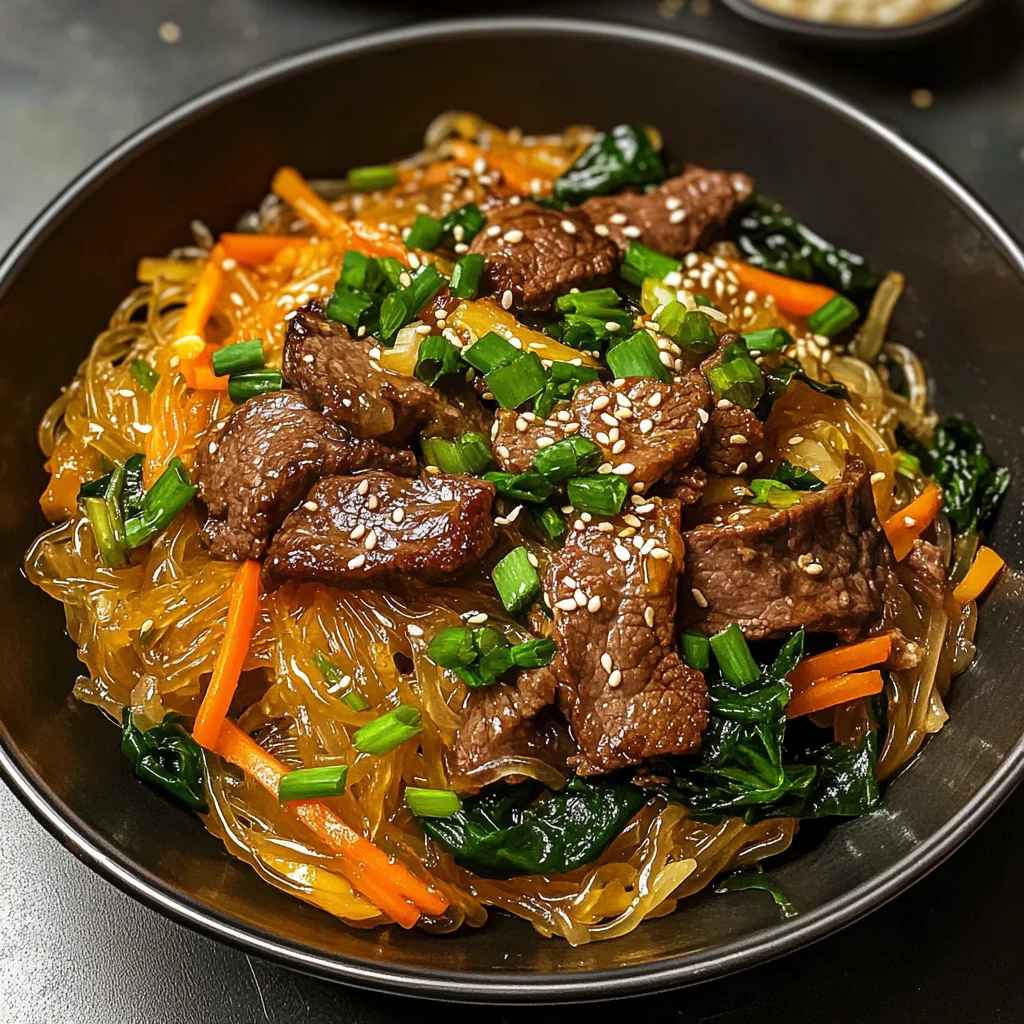
Make Ahead and Storage
Japchae is a fantastic dish for meal prepping! You can make a large batch to enjoy throughout the week, ensuring you have a delicious and nutritious meal ready whenever hunger strikes.
Storing Leftovers
- Store any leftover Japchae in an airtight container in the refrigerator.
- It will keep well for up to 3-4 days.
- If possible, separate the noodles from the vegetables and beef to maintain texture.
Freezing
- To freeze, place cooled Japchae in a freezer-safe container or bag.
- Be sure to remove as much air as possible before sealing.
- Frozen Japchae can last up to 2 months.
Reheating
- Thaw frozen Japchae overnight in the refrigerator before reheating.
- Reheat on the stovetop over low heat, adding a splash of water or sesame oil to prevent sticking.
- Alternatively, use a microwave-safe dish and heat in 30-second intervals until warmed through.
FAQs
Here are some common questions about making Japchae.
What type of noodles are used in Japchae?
Japchae is made with Korean sweet potato glass noodles, which have a unique chewy texture that sets this dish apart.
Can I customize my Japchae recipe?
Absolutely! You can customize your Japchae by swapping out proteins like chicken or tofu and adding your favorite vegetables or spices for extra flavor.
How do I enhance the flavor of my Japchae?
To enhance the flavor of your Japchae, consider adding some gochujang for spice or experimenting with different types of vegetables based on what you enjoy!
Is there a vegetarian option for Japchae?
Yes! Simply omit the beef and substitute it with tofu or additional vegetables. The dish remains hearty and satisfying without meat.
Final Thoughts
I hope you enjoy making this delightful Japchae recipe as much as I do! It’s not only satisfying but also versatile, allowing you to adapt it perfectly to your tastes. Whether you’re preparing it for a family dinner or enjoying leftovers throughout the week, each bite is sure to bring warmth and comfort. Happy cooking, and I’d love to hear how yours turns out!
Japchae
If you’re searching for a dish that embodies comfort and flavor, look no further than Japchae. This traditional Korean stir-fry features chewy sweet potato glass noodles tossed with an array of vibrant vegetables and your choice of protein, creating a delightful meal that’s both satisfying and easy to prepare. Perfect for busy weeknights or family gatherings, Japchae is a versatile recipe that allows you to customize ingredients based on your preferences. With its savory-sweet sauce and colorful presentation, this dish promises to bring joy to every table.
- Prep Time: 15 minutes
- Cook Time: 20 minutes
- Total Time: 35 minutes
- Yield: Serves approximately 6 people 1x
- Category: Main
- Method: Stir-frying
- Cuisine: Korean
Ingredients
- 2 lb thin-sliced beef (or substitute with chicken or tofu)
- 1 lb Korean sweet potato noodles
- 3 medium carrots, julienned
- 1 large white onion, thinly sliced
- 1/2 bunch green onions, chopped
- 6 garlic cloves, minced
- 1/2 lb spinach leaves
- 4 tbsp sesame oil
- 1 tbsp olive oil
- 6 tbsp soy sauce (or tamari for gluten-free)
- 3 tbsp brown sugar
Instructions
- Cook the Noodles: Boil water in a large pot with olive oil. Add sweet potato noodles and cook for about 5-6 minutes until tender but chewy. Drain and set aside.
- Sauté the Protein: In a skillet over high heat, cook the sliced beef until browned. Season with half of the soy sauce, sesame oil, and brown sugar. Set aside.
- Cook Vegetables: Heat olive oil in another skillet over medium heat. Sauté carrots and onion until softened. Add remaining soy sauce, sesame oil, brown sugar, garlic, and green onions.
- Add Spinach: Stir in spinach until wilted, then combine all cooked veggies with sautéed beef.
- Toss Together: In a large bowl, mix cooked noodles with the vegetable-beef mixture. Serve warm, garnished with extra green onions if desired.
Nutrition
- Serving Size: 1 cup (200g)
- Calories: 372
- Sugar: 7g
- Sodium: 890mg
- Fat: 12g
- Saturated Fat: 2g
- Unsaturated Fat: 8g
- Trans Fat: 0g
- Carbohydrates: 50g
- Fiber: 4g
- Protein: 22g
- Cholesterol: 60mg

